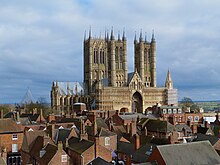
Back كاتدرائية لينكن Arabic Catedral de Lincoln AST Лінкальнскі сабор Byelorussian Лінкальнскі сабор BE-X-OLD Линкълнска катедрала Bulgarian লিঙ্কন মহাগির্জা Bengali/Bangla Lincolnská katedrála Czech Lincolnkatedralen Danish Kathedrale von Lincoln German Καθεδρικός ναός του Λίνκολν Greek
| Lincoln Cathedral | |
|---|---|
| The Cathedral Church of the Blessed Virgin Mary of Lincoln | |
 Lincoln Cathedral viewed from Lincoln Castle | |
| 53°14′04″N 0°32′10″W / 53.23444°N 0.53611°W | |
| Location | Lincoln, Lincolnshire |
| Country | England |
| Denomination | Church of England |
| Previous denomination | Roman Catholicism |
| Tradition | Anglo-Catholic |
| Website | lincolncathedral |
| History | |
| Dedication | Virgin Mary |
| Consecrated | 11 May 1092 |
| Architecture | |
| Style | Gothic |
| Years built | 1185–1311 |
| Groundbreaking | 1072[1] |
| Specifications | |
| Length | 147 metres (482 ft) |
| Width | 24 metres (78 ft) |
| Nave height | 24 metres (78 ft) |
| Number of towers | 3 |
| Tower height | 83 metres (272 ft) (crossing) |
| Number of spires | 3 (now lost) |
| Spire height | 160 metres (520 ft) (crossing tower) |
| Bells | 13 hung for change ringing; 20 in total (13 in South West tower, 2 in North West tower and 5 in the central tower) |
| Tenor bell weight | 23cwt 3qr 23lb (1212 kg) in D |
| Administration | |
| Province | Canterbury |
| Diocese | Lincoln (since 1072) |
| Clergy | |
| Dean | Vacant |
| Precentor | Nick Brown |
| Chancellor | Vacant |
| Laity | |
| Director of music | Aric Prentice |
| Organist(s) | Jeffrey Makinson |
| Chapter clerk | Tracy Buckby |
Building details | |
 | |
| Record height | |
| Tallest in the world from 1311 to 1548[I] | |
| Preceded by | Great Pyramid of Giza |
| Surpassed by | Tower of St. Mary's Church, Stralsund |
Lincoln Cathedral, also called Lincoln Minster and formally the Cathedral Church of the Blessed Virgin Mary of Lincoln, is a Church of England cathedral in Lincoln, England. It is the seat of the bishop of Lincoln and is the mother church of the diocese of Lincoln. The cathedral is governed by its dean and chapter, and is a grade I listed building.
The earliest parts of the current building date to 1072, when bishop Remigius de Fécamp moved his seat from Dorchester on Thames to Lincoln. The building was completed in 1092, but severely damaged in an earthquake in 1185. It was rebuilt over the following centuries in the Gothic style. The cathedral became the tallest building in the world upon the completion of its 160-metre-high (525 ft) central spire in 1311.[dubious ] It surpassed the Great Pyramid of Giza, and held the title until the spire collapsed in 1548 and was not rebuilt.[2]
The cathedral holds one of the four remaining copies of the original Magna Carta, which is now displayed in Lincoln Castle. It is the fourth largest cathedral in the UK by floor area, at approximately 5,000 m2 (50,000 sq ft), after Liverpool Cathedral, St Paul's Cathedral, and York Minster.[3] It is highly regarded by architectural scholars; the Victorian writer John Ruskin declared: "I have always held ... that the cathedral of Lincoln is out and out the most precious piece of architecture in the British Isles and roughly speaking worth any two other cathedrals we have."[4]
- ^ "Timeline – Lincoln Cathedral". Archived from the original on 4 October 2018. Retrieved 4 October 2018.
- ^ Cite error: The named reference
kendrickwas invoked but never defined (see the help page). - ^ "Floorplan – Lincoln Cathedral". Archived from the original on 15 September 2018. Retrieved 4 October 2018.
- ^ "Lincoln Cathedral – Guide | Cathedrals Plus". www.cathedralsplus.org.uk. Archived from the original on 9 December 2021. Retrieved 9 December 2021.
© MMXXIII Rich X Search. We shall prevail. All rights reserved. Rich X Search
